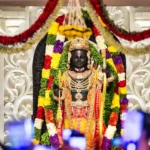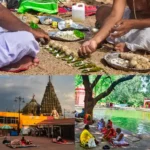Langar: The Emblem of Sikh Generosity
The concept of Langar, or the community kitchen, is one of the most distinctive and revered traditions of Sikhism. Established by Guru Nanak Dev Ji, the founder of Sikhism, Langar is not just a meal; it’s a powerful symbol of equality, selflessness, and community spirit.
A Meal for All: At the heart of Langar is the principle that everyone, regardless of their socio-economic status, religion, or background, should sit together as equals and partake in a meal. In the sprawling halls adjacent to the Golden Temple, thousands gather daily to enjoy a meal that’s prepared with love and devotion.
Selfless Service: The entire operation, from cooking to serving and cleaning, is carried out by volunteers. These volunteers, or ‘sevadars’, come from various walks of life, dedicating their time and energy to service to the community. Their selfless efforts embody the Sikh principle of ‘Seva’ or selfless service.

Simplicity and Nutrition: The Langar meal, though simple, is nutritious and wholesome. Typically consisting of chapatis (flatbreads), dal (lentil soup), vegetables, and a dessert, the meal is prepared using fresh ingredients and served to all visitors without distinction.
Sustainability and Efficiency: The scale of the Langar at the Golden Temple is immense, with the kitchen serving meals to over 100,000 people daily. Despite the vast numbers, the operation is a marvel of efficiency and sustainability. Modern equipment is used alongside traditional methods to prepare vast quantities of food, and efforts are continually made to minimize waste and ensure sustainability.
A Spiritual Experience: Partaking in Langar is not just about enjoying a meal; it’s a spiritual experience. The act of sitting in rows, or ‘pangat’, on the floor signifies humility and equality. As the food is served, visitors are reminded of the blessings of the Divine and the importance of gratitude.
Beyond the Temple: The tradition of Langar extends beyond the confines of the temple. Sikhs worldwide have adapted this practice to serve their local communities, especially during times of need. From disaster relief to feeding the homeless, the spirit of Langar is a beacon of hope and generosity.
In essence, Langar at the Golden Temple is more than a community kitchen; it’s a manifestation of the core Sikh values of love, equality, and selfless service. It stands as a testament to the community’s unwavering commitment to serving humanity and upholding the principles laid down by the Sikh Gurus.
Akal Takht: The Seat of Sikh Temporal Authority
The Akal Takht, translating to the “Throne of the Timeless One,” stands majestically opposite the Golden Temple. Established by Guru Hargobind Ji, the sixth Sikh Guru, in 1606, the Akal Takht is not just a structure but a symbol of the political sovereignty and justice inherent in Sikhism.

Foundation and Significance: Guru Hargobind Ji laid the foundation of the Akal Takht as a place where temporal matters concerning the Sikh community could be addressed. It was here that he donned two swords, representing spiritual (Piri) and temporal (Miri) authority, emphasizing the balance between spiritual devotion and worldly responsibilities.
Centre of Deliberation: Over the centuries, the Akal Takht has been the epicentre of crucial decisions affecting the Sikh community. From resolving disputes to issuing ‘Hukamnamas’ (edicts) and guiding the community during turbulent times, the Takht has played a pivotal role in shaping the socio-political trajectory of Sikhism.
Architectural Grandeur: The Akal Takht is a five-story structure, with each level adorned with intricate designs and symbols representing various aspects of Sikh history and philosophy. The facade is decorated with marble sculptures, inlaid with precious stones, reflecting the artistic heritage of the Punjab region.
Guardian of Sikh Relics: The Akal Takht houses an array of historical artefacts, including weapons and personal belongings of the Sikh Gurus. These relics are a testament to the martial spirit of Sikhism and the sacrifices made by the community throughout history.

A Symbol of Resilience: The Akal Takht has witnessed numerous challenges, most notably during Operation Blue Star in 1984 when it suffered significant damage. However, in the true spirit of Sikh resilience, the community came together to restore the Takht, ensuring that its sanctity and significance remained undiminished.
Spiritual and Temporal Harmony: While the Golden Temple represents the spiritual essence of Sikhism, the Akal Takht embodies its temporal authority. Together, they symbolize the harmonious blend of spirituality and worldly affairs, a core tenet of Sikh philosophy.
In essence, the Akal Takht is not just a physical structure but the very embodiment of Sikh pride, valour, and governance. It stands as a beacon of justice, righteousness, and sovereignty, guiding the Sikh community through the annals of time with unwavering resolve and vision.
The Central Library: Preserving Sikh Heritage
Nestled within the precincts of the Golden Temple complex is the Central Sikh Museum, often referred to as the Central Library. This institution is more than just a repository of books; it’s a treasure trove that safeguards the rich tapestry of Sikh history, culture, and spirituality.
Historical Chronicles: The library boasts an extensive collection of manuscripts, historical documents, and literature that trace the evolution of Sikhism from its inception to the present day. These chronicles offer invaluable insights into the teachings of the Sikh Gurus, the challenges faced by the community, and the milestones that have shaped Sikh identity.

Artistic Heritage: Beyond written records, the Central Library is home to a vast array of paintings, photographs, and artefacts. These visual narratives capture pivotal moments in Sikh history, from the spiritual teachings of Guru Nanak Dev Ji to the valiant battles led by Guru Gobind Singh Ji. The artwork, with its intricate detailing and emotive portrayals, brings to life the ethos and spirit of Sikhism.
Digital Archives: Recognizing the importance of preserving this heritage for future generations, the library has undertaken extensive digitization efforts. Ancient manuscripts, rare books, and photographs are now available in digital formats, ensuring their longevity and accessibility to a global audience.
Educational Initiatives: The Central Library is not just a place of preservation but also learning. Regular workshops, seminars, and exhibitions are organized to educate visitors about Sikh history and philosophy. These initiatives foster a deeper understanding and appreciation of Sikhism’s rich legacy.
A Sanctuary of Reflection: Amidst the hustle and bustle of the Golden Temple complex, the library offers a space of quiet reflection. Visitors can immerse themselves in the writings of the Gurus, delve into historical accounts, or simply sit in contemplation, surrounded by the wisdom of the ages.
Guardians of Heritage: The dedicated staff and scholars at the Central Library work tirelessly to catalogue, restore, and research the vast collection. Their efforts ensure that the library remains a vibrant and evolving institution, continually adding to its reservoir of knowledge.

In essence, the Central Library is a bridge between the past and the present, ensuring that the rich heritage of Sikhism is not only preserved but also shared with the world. It stands as a testament to the community’s commitment to knowledge, education, and the eternal values espoused by Sikhism.
Jallianwala Bagh: A Stone’s Throw Away
Just a short walk from the Golden Temple lies Jallianwala Bagh, a public garden that holds a poignant place in India’s history. While the serene ambience of the park today stands in stark contrast to its tragic past, the echoes of that fateful day in 1919 still resonate, reminding visitors of the sacrifices made in the quest for freedom.
The Tragic Event: On April 13, 1919, thousands gathered at Jallianwala Bagh to peacefully protest against the oppressive Rowlatt Act imposed by the British colonial rulers. Without warning or provocation, Brigadier General Reginald Dyer ordered his troops to open fire on the unarmed crowd. The massacre that ensued left hundreds dead and thousands injured, marking one of the darkest chapters in colonial India’s history.

The Martyrs’ Well: A prominent feature of the garden is the Martyrs’ Well, into which many jumped to escape the hail of bullets. Today, it stands as a solemn reminder of the lives lost and the extreme measures people took in their desperate bid for survival.
The Bullet-Marked Walls: The walls of Jallianwala Bagh still bear the bullet marks from that day, preserved to remind visitors of the brutality of the massacre. These scars, etched in stone, serve as silent witnesses to the atrocities of that day.
The Flame of Liberty: At the entrance of the garden stands a memorial, erected in honour of the victims. The central structure, with its eternal flame, pays tribute to the indomitable spirit of those who laid down their lives for the cause of freedom.
A Place of Reflection: Today, Jallianwala Bagh is not just a historical site but a place of reflection and education. Informative plaques, a museum, and audio-visual exhibits provide insights into the events leading up to the massacre, its aftermath, and its significance in India’s freedom struggle.

Legacy and Significance: The tragedy of Jallianwala Bagh galvanized the Indian freedom movement, uniting people across the country in their resolve to end British rule. Leaders like Mahatma Gandhi and Rabindranath Tagore vehemently condemned the massacre, and it became a turning point, intensifying the demand for India’s independence.
In essence, Jallianwala Bagh stands as a testament to the resilience and sacrifice of the Indian people. While the events of that day were tragic, the legacy it left behind is one of hope, unity, and an unwavering commitment to freedom and justice.
Discover the Spiritual Essence with Prayag Samagam
While the tales and traditions of the Golden Temple beckon travellers from around the world, the journey’s true essence lies in experiencing it firsthand. With Prayag Samagam, your pilgrimage becomes more than just a visit; it transforms into a deeply immersive experience.
Specializing in religious tourism, we at Prayag Samagam curate tours that not only cover iconic landmarks but also delve deep into the stories, rituals, and traditions that make these places truly special.

Our expert guides, well-versed in Sikh history and culture, ensure that every moment of your journey is enriching. From understanding the profound teachings of the Gurus to participating in the community services at the Langar, we ensure a holistic experience that touches both the heart and soul.
So, as you read about the wonders of the Golden Temple and its surrounding landmarks, remember that the real magic lies in being there, feeling the energy, and soaking in spirituality. And with Prayag Samagam, you’re not just a tourist; you’re a seeker on a path of discovery.































